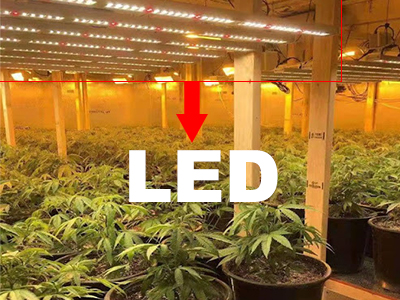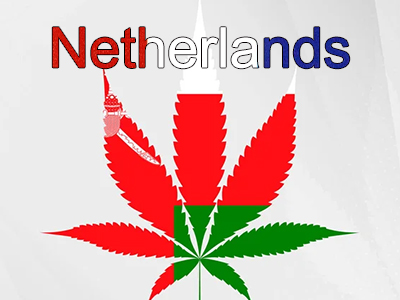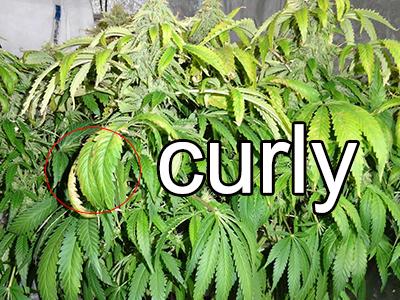Light quality has a great impact on plant growth and development, photosynthetic characteristics, yield and quality. Studies have shown that green light and red light significantly promote the elongation of colored sweet pepper seedling stems, blue light has a dwarfing effect on seedlings, and composite light has a better effect than monochromatic light, and is significantly longer under green light.
Effect Of Light Quality On Vegetable Quality
Red light is not conducive to the increase of chrysanthemum stems, and the red light-treated stem length is 43.0% less than that of the control.
There are also reports that red light is conducive to the thickening of stems of chrysanthemum plants. Increasing the ratio of blue light can effectively reduce the plant height of cucumber seedlings. Increasing the ratio of red light can make photosynthesis products more transported to the leaves of seedlings.
The chlorophyll a, chlorophyll b, and carotenoids of lettuce all increased with the increase of the proportion of blue light. After treatment with blue light or increasing the proportion of blue light, the chlorophyll content of the plant was significantly increased and the photosynthetic rate of the plant was significantly increased.
This shows that a higher blue light intensity ratio may be beneficial to the synthesis of photosynthetic pigments. The photosynthesis of plants containing 7% blue light in the combination of red and blue light can operate normally; as the proportion of blue light increases, the photosynthetic capacity of the leaves also increases, but the photosynthetic capacity of the leaves decreases when the proportion of blue light exceeds 50%.
Under single-light light quality, plants have more dry matter accumulation, longer internodes, smaller stem thickness, smaller leaves, and higher total sugar content; plants under single-light light quality have less dry matter accumulation, the internodes are shorter and the stems are thicker, which inhibits the stem's elongation and growth to some extent. Red light-treated cucumber seedlings had the highest soluble sugar content and blue light-treated cucumber had the highest soluble protein content.
Compared with the control, there were significant differences. Chlorophyll content of tomato seedlings treated with red light increased, stomatal conductance and transpiration rate increased, photosynthetic rate was significantly higher than that of other treatments; chlorophyll content of blue light treated was slightly lower, but photosynthetic rate was still significantly higher than that of control, probably due to blue light promotion The stomata are open, increasing the intercellular CO2 concentration of the leaves. The increase in stomatal conductance of plant leaves was specifically induced by blue light.
For most plants, red light promotes the increase in leaf area. Under the red light treatment, the leaves of radish seedlings, toon seedlings, tomatoes, cucumber seedlings, tobacco, grass poison, and lettuce expanded faster and the leaves were larger.
Similarly, blue light can increase leaf area, but blue light suppresses leaf expansion of tobacco, poinsettia, and moss.
Adding blue light to red light can significantly increase the leaf area of lettuce. The area of spinach leaves was significantly larger in red, blue and yellow light treatments than in other treatments. Red light treatment is beneficial to the dry matter accumulation of tomato, eggplant, cucumber, lettuce, and other crops. The combination of red and blue light promoted the increase in biomass of pepper, phalaenopsis, weiwei and cucumber. Adding green, yellow, purple, and white lights to the combination of red and blue lights has a significant effect on the biomass of lettuce, cherry tomatoes, and non-heading cabbage.
Under the red light is beneficial to the accumulation of carbohydrates in plants. Under red light treatment, the soluble sugar content of spinach, cucumber, pepper, tomato seedlings, and radish sprouts can be significantly increased. Red light can promote starch accumulation, which has been reported on crops such as soybeans, cotton, oil sunflower sprouts, and rapeseed. Because the output of photosynthetic products in the leaves can be suppressed by red light so that starch is accumulated in the leaves. The change of soluble protein content in leaves is one of the reliable indicators reflecting the physiological function of leaves.
Blue light is good for protein synthesis. Blue light promoted the soluble protein content of pea seedlings, lettuces, cucumbers, and sprouts. Blue light significantly promoted the increase of total amino acid and sugar content in chrysanthemum leaves. Current research has found that blue light can significantly promote the dark breathing of mitochondria, and organic acids produced during breathing can be used as a carbon framework for the synthesis of amino acids, which is beneficial to protein synthesis.
The compound spectrum also has different promotion effects on the photosynthetic products of plants. Huang Guang is beneficial to the synthesis of soluble sugar and protein in lettuce, the formation of sucrose content in tomato and the accumulation of free amino acids in rape sprouts.
The combination of low-dose UV-B and red light significantly increased the accumulation of sugar content in tomatoes. Blue light and UV-A can promote protein synthesis in cucumber fruits. The combination of blue-red light promotes the accumulation of soluble proteins and soluble proteins.
Red, blue and white complex light promotes the synthesis of soluble sugar and nitrogen content. The total starch content of tomato seedlings treated with the combination of red, blue and green light was the worst.
As an endogenous active oxygen scavenger in plants, SOD can maintain high activity under adverse conditions to effectively remove active oxygen and keep it at a low level, thereby reducing its damage to membrane structure and function. The study found that the color of sweet pepper seedlings had the highest SOD activity under green light, and there was no significant difference between blue light and red light.
POD is an active oxygen scavenger. The increase of its activity can reduce the damage of active oxygen to the membrane, and the POD activity is the lowest under green light.
CAT can remove free radicals and maintain the integrity of the membrane system to reduce the harmful effects of the adverse environments on plants. CAT activity is highest in white light, followed by blue light, CAT activity is higher under green light, and the enzyme activity is under yellow and red similar. Purple light and blue light can alleviate the senescence of plants by increasing the activity of CAT and other antioxidant enzymes and their gene expression, delaying the degradation of chlorophyll and soluble proteins, and membrane peroxidation.
Red light and blue light are the main light sources absorbed by plants, and they are also the signal light sources for the main photoreceptors of plants. Under low-light conditions, supplementary light with LED red and blue light sources can effectively control the length of cucumber seedlings, improve the quality of seedlings, and alleviate the damage caused by physiological stress under low-light conditions. The combination of red and blue light promoted the biomass accumulation of pepper, rice leaflet seedlings, and lettuce plants.
The combination of red and blue light sources with 60% blue light may be a relatively good light source for cherry tomato fruit.
The leaf area value of tomato seedlings under red / blue (2: 1) supplemental light conditions was the largest, but the leaf area values under red/blue (7: 1) supplemental light conditions were relatively small in the red-blue composite light, indicating that red light Increasing the proportion can only promote leaf growth within a certain range.
Red light is beneficial to the radial growth of stems and leaves of oilseed rape. Properly increasing the ratio of blue light is beneficial to the lateral growth of stems and leaves, root development and photosynthetic pigment synthesis.
Vegetables grow, increasing biomass and nutrient content. Low light conditions will reduce the soluble protein content of cucumber seedlings. After red and blue supplementary light, the soluble protein increased significantly. The soluble sugar content and soluble protein content in tomato seedling leave under red / blue (2: 1) supplemental light reached maximum values.
LED mixed red and blue light sources treat gourd and pumpkin seedlings with developed root systems, high dry matter content, increased seedling index, and improved seedling quality; the increase in blue light components in red and blue mixed LED lights inhibits seedling stem elongation and promotes seedling stems Rough increase.
The cotyledon area, soluble sugar, starch, carbohydrate, sucrose, and C / N of lettuce seedlings under red and blue light were the largest and significantly higher than those of red light, indicating that adding the appropriate amount of blue light to red light was more conducive to the carbohydrate accumulation of lettuce seedlings. 25% and 50% blue light treatment is beneficial to the accumulation of lettuce biomass, more photosynthetic pigment content, larger leaf area, thicker leaves, is conducive to photosynthesis, while the root system is well developed, the activity is strong, and it is good for nutrients And water absorption, growth is better than other treatments. The chlorophyll content was greatly affected by the R / B ratio, and blue light significantly reduced the chlorophyll content in strawberry leaves.
Red light at 660 nm and blue light at 450 nm can regulate the chlorophyll content of lettuce. With the increase of blue light and the decrease of red light, the content of chlorophyll a and b gradually decreases. The net photosynthetic rate and stomatal conductance of cucumber seedlings treated with the combination of red and blue light were the largest. The net photosynthetic rate, stomatal conductance, and transpiration rate of single red and blue light were smaller, but the intercellular CO2 concentration was higher. Properly increasing blue light can increase the antioxidant enzyme activities of tomato seedlings. With the increase of the proportion of red light, the activities of antioxidant enzymes such as SOD and CAT increased first and then decreased. Under R / B (2: 1) supplementary light SOD activity decreases.
Most studies have shown that blue light can reduce the fresh and dry weight of plants. With the increase in the proportion of blue light, the trends of dry weight and fresh weight of lettuce both increased first and then decreased.
At different growth stages, blue light has different effects on the biomass of Wakata. The biomass increase in the early growth period is inversely proportional to the red/blue value, and in the later growth period, it is directly proportional to the red/blue value. Blue-violet light can inhibit stem elongation. Compared with white light, blue-violet light significantly reduced the height of ginger plants and increased their stem thickness. In terms of the effect of light quality on the root system, some studies have shown that blue and purple light-treated oat plants have more roots and developed root systems.
The study found that the combination of red/blue (1: 1) light energy can significantly improve the growth and quality indicators of lettuce; red/blue (7: 3) is the most suitable light quality condition for cucumber seedling growth, and the maximum photosynthetic rate can reach monochrome red 4 times under light.
When red/blue was 8: 1, lettuce showed an obvious photosynthetic advantage. Adding yellow light to the red-blue complex light is beneficial to the synthesis of spinach photosynthetic pigments and significantly promotes the growth of spinach. Adding yellow light and purple light can increase the photosynthetic potential of cherry tomato seedlings, and alleviate the red and blue weak light stress.























